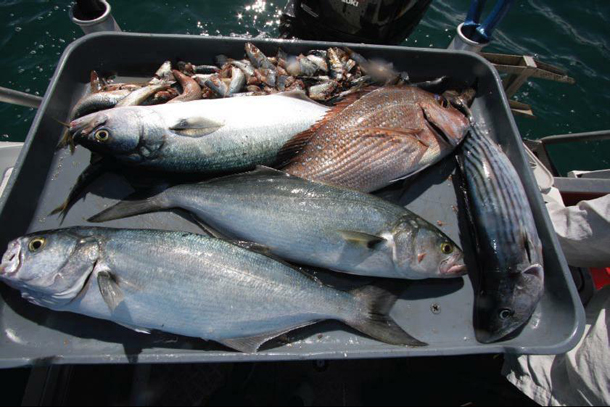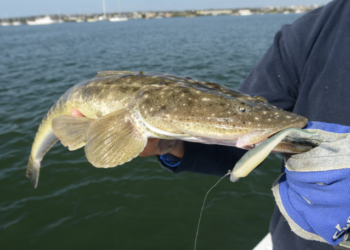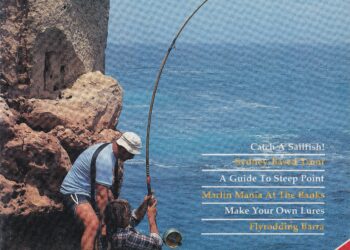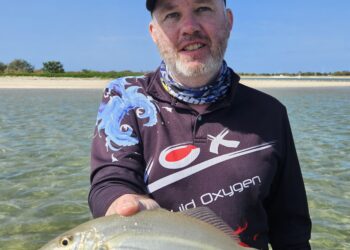How to: Berley Up
The best way to catch more fish is to make them hungry. DAVID GREEN details the lost art of berleying.
BERLEYING seems to have become a bit of a lost art. A lot of this is due to the fact we tend to use a lot more lures, and move around from spot to spot chasing fish, rather than the anchored boat approach where berley is used to bring the fish to the angler. The clever use of berley, however, is probably the most effective way to catch schooling fish in numbers, both in the estuaries and offshore. There are a few important rules when it comes to using berley, and it requires a bit of preparation and planning. The most important is that you must get the berley into the right part of the water column to attract fish to your baits or lures.
There are many types of berley, and in some situations the berley used is there to attract baitfish, which then attract other predators. This is how using berleys such as bread or chicken pellets can help you catch species such as mulloway and flathead. They generally won’t eat the berley used, but the big schools of yellowtail attracted to your berley trail attract a wide range of predators. In other cases, such as berleying for sharks, you need a much more specific approach. Shark sense organs are highly attuned to picking out fish oils from seawater, and a long trail of tuna oil will be sensed by a patrolling shark from many kilometres. In this situation the berley trail isn’t necessarily providing a source of food; rather, it’s providing a source of scent that the shark assumes will lead to a food source.
Some pelagic species such as yellowfin tuna tend to hunt by sight, and berleying for tuna requires the use of “chunks” or “cubes”. If you cut up baitfish or tuna flesh into 2cm cubes and then drop a single cube into a current every 30 seconds to a minute, you’ll establish a “cube trail”. While each individual piece is small, the underwater visual attraction of a long trail of juicy morsels can attract fish from considerable distance, and in medium to heavy current a cube trail is very easy to see for predators in the surface or mid depths, as the overall image created by the long line of cubes gives a very big profile. Tuna feed along the cube trail until they find its source, at which time they can be presented a cube with a hook in it.
Snapper are probably the easiest of all offshore species to attract to a berley trail. Snapper are very inquisitive fish and eat a wide range of prey. They are opportunist feeders and will switch on to anything that stimulates their sense of smell or offers them an easy feed. They also leave the bottom layers to feed midwater or close to the surface. Years back, fishing in 30m of water, I was berleying for snapper by mashing tuna through my berley pot. It was pre-dawn and we were catching plenty of fish.
I looked over the back to see a decent snapper actually pulling pieces of tuna out of the holes in the pot. He bolted back to the deep water when I stood up. That fish had obviously followed the berley to its source. This behaviour explains why it’s quite common to catch a snapper in a berley trail very close to the boat. If you minimise your noise and keep a low profile you may catch snapper within a few metres of your berley pot. Sometimes when fishing for snapper, it is best to spend an hour or more berleying before you actually begin fishing. This will get the school of fish feeding aggressively close to the boat and will help your catch rate as hookups in the midwater or surface layers offer you a much better chance of landing the fish. This particularly applies when fishing in areas of kelp.
There are also situations of “natural berley”. Hot water outlets, milk factories and the previously infamous sewer outlets called the “Murk” near Sydney are examples of man-made structures with outflows that contain fish attracting nutrients. Last year an adult hump backed whale died during the whale migration off the Gold Coast. This massive lump of berley attracted a phenomenal range
of species from dolphin fish to great white sharks. There were tiger sharks in huge schools, a million baitfish and even blue marlin were close to the whale. On a much smaller scale, feeding schools of pelagics such as tuna and tailor often generate plenty of food that sinks down below, and this often attracts species such as snapper and mulloway. The important thing about natural berley systems is to appreciate how effective they are and fish them whenever you come across them. One of the clueyest whiting anglers I have ever seen caught a lot of his fish by fishing baits behind any dredge he saw in the Nerang River, near the Gold Coast. While dredging up the bottom can be a form of environmental vandalism, there is no argument as to its effectiveness in attracting fish to feed upon all the bottom invertebrates and molluscs dug up by the dredge.
Delivery Systems
What are you trying to attract? Where do these fish live? What do they feed on?
If you can answer these questions you should be able to work out the best way to berley the fish close to your boat. One of the trickiest scenarios is attracting deep-water species by effective berleying when there is a bit of current. In days gone by we did a lot of fishing for mulloway on deep offshore reefs. We berleyed by having a heavy handline and a 12/0 hook with a 500 gram sinker attached. To the hook we would attach a dozen or so pilchards or yellowtail hooked loosely through the skin. This would be lowered to the bottom and then vigorously jerked up and down to release the berley into the zone where the mulloway would be hiding. This was a highly effective method and by the gut content of the fish it was clear they had eaten the berley prior to being hooked on bait. There are a number of commercial products that let you deliver berley down to the depths, and they all work. We also used to tie an onion bag of berley and tuna frames to the anchor where the chain joins the rope on a loose cord but lost interest in this method when tiger sharks bit off the rope. All of these types of systems use weight to get the berley down to the fish rather than drifting off in the current.
Berley pots mounted on the transom of a boat are a great way to spread a fine trail of berley that will slowly sink into the depths, depending on the current flow. To effectively berley for species such as snapper and bream requires a bit of current to disperse your berley. If the current is too strong the berley won’t reach the fish until it is well away from the boat. If there is no current at all the berley will sink straight below and not bring in fish from a distance. Just a trickle of current is all you need. I like to use tuna frames, old pilchards and any oily fish in the berley pot, but over the years everything from crab shells to bread has been crunched by my berley masher. It is important that you have a robust and strong berley pot with plenty of big holes to release your berley, because you generally spend quite a few hours working the pot. A heavy metal masher makes a big difference. We use a lot of mackerel tuna in our berley pot, as they are generally common, not good eating but very oily and make excellent berley for a wide range of species. I’d use two or three 6-kilo tuna in an average snapper session.
Cube trails require a set of decent knives and a good cutting board. Pilchards, slimies, yakkas and tuna all make excellent cubes. As a cube is heavier than the mash that comes out of your berley pot, it tends to sink faster and is often a more useful method if the current is strong. I find it very effective to mash a tuna frame in the pot and cut the fillets into cubes and bait strips. This method works extremely well in my local waters for cobia, spotted and Spanish mackerel, snapper, kingfish and mulloway. If I am after bigger fish I use bigger cubes. Cobia and mackerel will follow a cube trail all the way to the boat and sometimes surprise you as they appear just out the back of the transom. Last winter I was snapper fishing with a cube trail in strong current and my bait was eaten just as it sank out of sight by a 20kh+ wahoo that lit up like a purple rocket a second before I was bitten off. A good cube trail attracts a lot of predators, and even marlin will respond at times, which can be fun!
Because a mixed berley trail of mash and cubes attracts a wide range of fish, it pays to have a few rods set. I like a live slimy about 40m back, usually under a piece of Styrofoam. If mackerel are around I use a small amount of wire. A floating pilchard with minimal or no lead can be floated down the trail, and a cube similar to that used in the trail can be fed out a long distance in free spool. This is a great way to fish on most productive reefs and is particularly effective when the fishing is tough and not much is being caught. These are the situations where berley is the best method.
Berley Types
If you are serious about berleying you need an old freezer in your back shed. Wives and girlfriends never understand the fact that six big mack tunas should displace frozen veggies in a battle for freezer space. You will soon become a berley “collector”, an interesting past time. Keep all your old bait, fish frames, prawn heads, crab shells and scraps and recycle them through your berley pot. If you spend a bit of time trolling at sea or spinning for pelagics you will generally have access to different types of tuna. Keep these for berley, bait and crab bait.
Other useful berley includes bread, chicken pellets, wheat and old biscuits. This attracts a range of good fish and a lot of baitfish to your boat. Snapper and bream are very susceptible to chicken pellet berley, and it is cheap and easy to store. It also has the advantage of not attracting sharks. Commercially available tuna oil is a very good additive. I don’t use any of the commercial berley products as I have access to plenty of fish frames, but any type of berley is better than nothing at all. Some fish co-operatives will sell you mullet frames at a very cheap price and these are excellent berley both in the estuaries and offshore.
There are some situations where unusual berley techniques are effective. Chopped green weed mixed with sand is a great berley for luderick, and fish frames in an onion bag staked in to the sand can berley up a surprising number of big bream when beach fishing. A scoop of live pilchards thrown near a tuna school will cause the fish to erupt, and this method is extensively used by commercial boats to pole tuna. Some anglers freeze their berley in blocks, mincing up fish frames, mixing in tuna oil and bread and then letting the block thaw out in a mesh bag behind the boat. This is a great way to attract yellowtail and slimy mackerel that you can catch for live baits and cubes.
Berleying is one of the most underused yet effective methods of increasing your catch. In any situation where you want to attract fish to your boat nothing works better than the aroma and taste of the food the fish want to eat.

A mixed bag of snapper, bonito and good sized tailor, thanks to some effective berley.

Berley buckets attached to the boat’s transom are a good way of berleying.




















